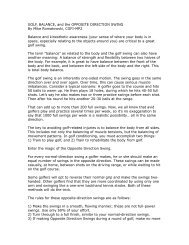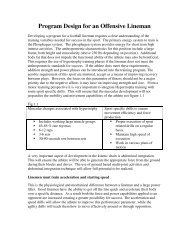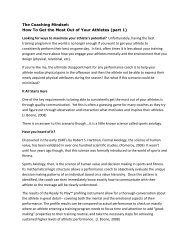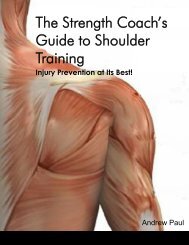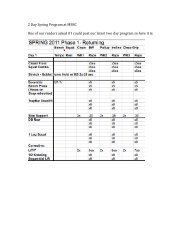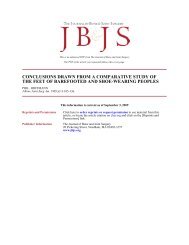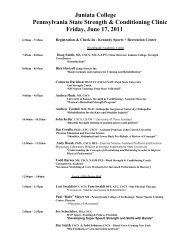Sprint Interval Training - “It's a HIIT - Strength Coach.com
Sprint Interval Training - “It's a HIIT - Strength Coach.com
Sprint Interval Training - “It's a HIIT - Strength Coach.com
Create successful ePaper yourself
Turn your PDF publications into a flip-book with our unique Google optimized e-Paper software.
groups of athletes can be considered very lean, the sprinters have a higher lean body mass despite burning far<br />
fewer calories while engaging in their athletic event 54,55 . <strong>Sprint</strong>ers also possess a physique that I am confident the<br />
majority of people would be happier to develop. The picture on the cover page of this article perhaps conveys this<br />
better than words. Also, when looking at that picture, ask yourself intuitively which body would be the healthiest<br />
and most successful for overall human performance?<br />
Now to me, it almost seems like an insult to one’s intelligence to have to address the research on fat loss<br />
when the sporting world is full of examples such as the marathon runner and sprinter. However, as health care<br />
professionals, we need research examples at our fingertips to <strong>com</strong>bat the objections that will undoubtedly <strong>com</strong>e<br />
your way because of, again, the indoctrinated dogma that the best way to burn fat is LMICT. First, it is, again,<br />
irrelevant as to how much research has demonstrated that LMICT can lead to a positive benefit – in this case, the<br />
benefit being fat loss. So, I will concede, as you should to your clients, that there is a significant body of research<br />
showing that one can lose fat by partaking in LMICT; however, there is also a significant amount showing it to be<br />
unsuccessful. The most relevant research at this point is to assess studies that <strong>com</strong>pare SIT and <strong>HIIT</strong> to LMICT and<br />
determine the most effective fat loss method factoring in, again, the issue of time <strong>com</strong>mitment.<br />
In 1990, Tremblay et al., published the findings of a study that showed, for a given level of energy<br />
expenditure, individuals engaging in vigorous activities are leaner than those participating in less intense<br />
activities 56 . To help understand this finding, they followed the report with a study that <strong>com</strong>pared the effect of a<br />
20‐week LMICT program upon body fatness and muscle metabolism with a 15‐week <strong>HIIT</strong> program 57 . Despite the<br />
fact that the energy expenditure of exercise was twice as high in the LMICT (with a mean estimated energy cost of<br />
120.4 MJ) as in the <strong>HIIT</strong> program (with a mean estimated energy cost of 57.9 MJ), there was a more pronounced<br />
reduction in subcutaneous fat (measured as the sum of six skinfolds) with the <strong>HIIT</strong> program <strong>com</strong>pared with the<br />
LMICT program. When the difference in the total energy cost of the two training programs was taken into account,<br />
the reduction induced by the <strong>HIIT</strong> program was actually ninefold greater than the LMICT program. Muscle biopsies<br />
were also taken before and after the training programs to examine the effect of the two training programs upon<br />
19



